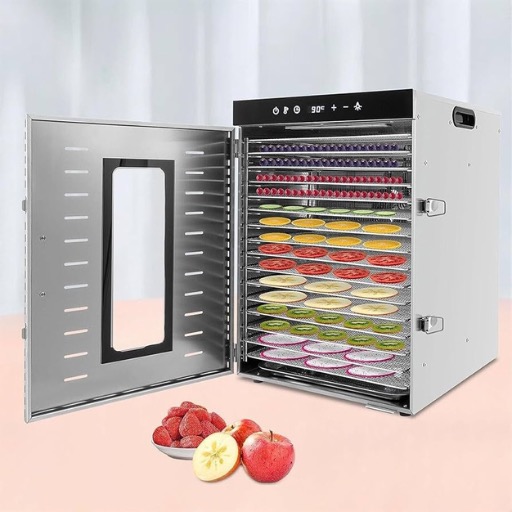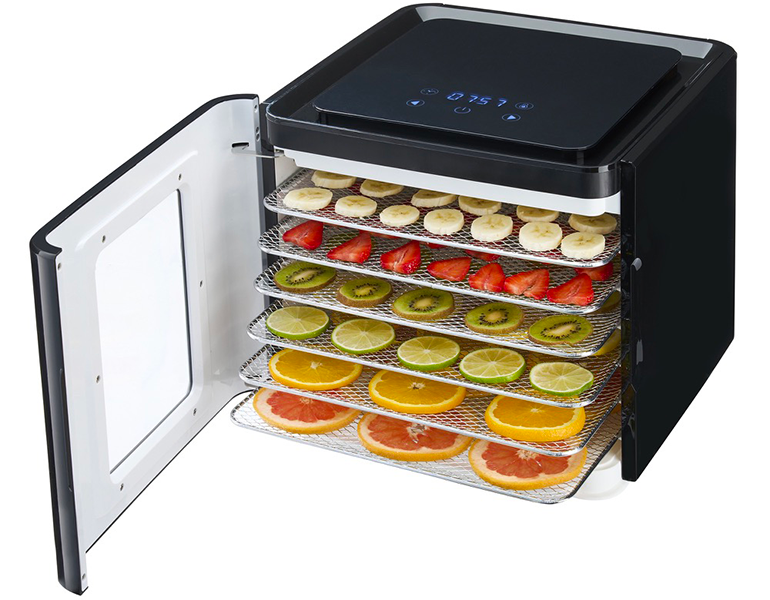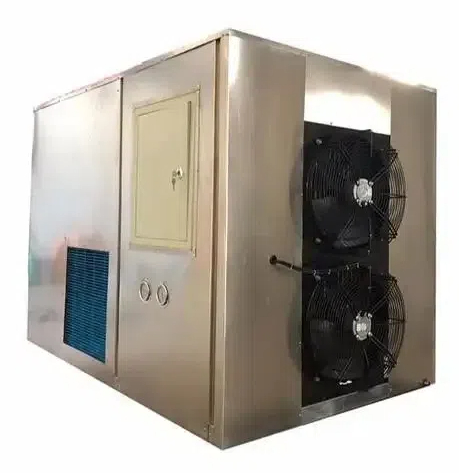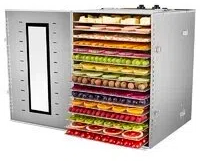
Content Menu
● Understanding Food Dehydration
● Types of Food Dehydrators
● Heat Pump Dryers
>> How They Work
>> Advantages
>> Applications
● Condenser Dryers
>> How They Work
>> Advantages
>> Applications
● Comparing Heat Pump and Condenser Dryers
● Choosing the Right Dehydrator for Your Needs
● Additional Considerations in Food Dehydration
>> Quality Control
>> Safety Standards
>> Market Trends
>> Environmental Impact
● Conclusion
● Frequently Asked Questions
>> 1. What types of foods can be dried using these dehydrators?
>> 2. How long does it typically take to dehydrate food?
>> 3. Are there specific maintenance requirements for these dehydrators?
>> 4. Can I use my dehydrator for making snacks like jerky or fruit leather?
>> 5. What is the average lifespan of a food dehydrator?
Food dehydration is a time-honored method of preserving food, extending shelf life, and enhancing flavors. As a manufacturer of food dehydrators, understanding the nuances of various drying technologies is crucial for providing quality products to your customers. In this article, we will explore the differences between heat pump dryers and condenser dryers, focusing on their mechanisms, advantages, and applications in food dehydration.

Understanding Food Dehydration
Food dehydration involves removing moisture from food items to inhibit the growth of bacteria, yeast, and mold. This process not only preserves food but also concentrates flavors and nutrients. The key to effective dehydration lies in the method used to remove moisture, which can significantly impact the quality of the final product.
Types of Food Dehydrators
There are several types of food dehydrators available in the market, including:
- Traditional Electric Dehydrators: These units use electric heating elements and fans to circulate warm air around the food. They come in various designs, including stackable and box-style models.
- Heat Pump Dehydrators: These advanced dehydrators utilize a heat pump system to efficiently remove moisture at lower temperatures.
- Condenser Dehydrators: These units operate by heating air to high temperatures and then condensing the moisture extracted from the food.
Heat Pump Dryers
How They Work
Heat pump dryers operate using a closed-loop system that recycles hot air. The process begins when warm air is circulated through the dehydrator, where it absorbs moisture from the food. This moist air is then passed through an evaporator that removes the moisture, allowing the remaining dry air to be reheated and reused in subsequent cycles.
Advantages
- Energy Efficiency: Heat pump dryers consume significantly less energy than traditional methods because they recycle hot air rather than expelling it.
- Lower Operating Temperatures: By operating at lower temperatures (typically around 50°C), heat pump dryers preserve more nutrients and flavors in the food.
- Versatility: These dryers can handle a variety of foods, from fruits and vegetables to meats and herbs.
- Extended Shelf Life: Foods dried using heat pump technology can have a longer shelf life due to better moisture control.
Applications
Heat pump dryers are particularly well-suited for:
- Fruits and Vegetables: Maintaining color and flavor while removing moisture effectively.
- Herbs and Spices: Preserving essential oils and aromatic compounds for enhanced flavor profiles.
- Meat Products: Producing jerky or dried meats with optimal texture and taste.

Condenser Dryers
How They Work
Condenser dryers function by heating air to high temperatures (70-75°C) before circulating it through the food. As the hot air absorbs moisture, it condenses into water, which is collected in a tank or drained away.
Advantages
- Faster Drying Times: Due to their higher operating temperatures, condenser dryers can dry foods more quickly than heat pump models.
- Simplicity: These units are often easier to operate and require less technical knowledge to use effectively.
- Cost-Effective: Generally, condenser dryers are less expensive upfront compared to heat pump models.
Applications
Condenser dryers are ideal for:
- Bulk Drying Operations: Where speed is essential for processing large quantities of food.
- Tougher Foods: Such as root vegetables or dense meats that require higher temperatures for effective drying.
- Commercial Use: In settings where quick turnaround times are necessary, such as restaurants or catering services.
Comparing Heat Pump and Condenser Dryers
| Feature | Heat Pump Dryer | Condenser Dryer |
| Energy Consumption | Low (recycles hot air) | High (expels hot air) |
| Operating Temperature | Low (around 50°C) | High (70-75°C) |
| Drying Time | Longer | Shorter |
| Nutrient Preservation | Excellent | Moderate |
| Initial Cost | Higher | Lower |
| Maintenance Needs | Moderate | Low |
Choosing the Right Dehydrator for Your Needs
When deciding between a heat pump dryer and a condenser dryer for your food dehydrating needs, consider the following factors:
- Type of Food Being Dried: If you are primarily drying delicate items like herbs or fruits that benefit from lower temperatures, a heat pump dryer may be more suitable. For tougher items or bulk drying where speed is essential, a condenser dryer might be preferable.
- Energy Efficiency Goals: If reducing energy costs is a priority for your operation, investing in a heat pump dryer could lead to significant savings over time.
- Budget Constraints: While heat pump dryers may offer long-term savings through energy efficiency, their higher initial cost may be a barrier for some businesses. Assess your budget and consider potential return on investment.
- Space Availability: Ensure that you have adequate space for installation. Heat pump dryers often require more room due to their design and components.
Additional Considerations in Food Dehydration
Quality Control
Maintaining quality control during the dehydration process is vital. Factors such as humidity levels in your facility, temperature fluctuations, and airflow can all affect drying efficiency. Implementing strict monitoring protocols can help ensure consistent results across batches.
Safety Standards
Adhering to safety standards is crucial when producing dehydrated foods. Ensure that your equipment meets local regulations regarding food safety. This includes proper sanitation practices during processing and packaging to prevent contamination.
Market Trends
Staying informed about market trends can help you tailor your products to meet consumer demands. There is an increasing interest in healthy snacks made from dehydrated fruits and vegetables. Consider developing innovative recipes or product lines that cater to this growing market segment.
Environmental Impact
As sustainability becomes more important in manufacturing processes, consider how your choice of dehydrator impacts energy consumption. Heat pump dryers are generally more environmentally friendly due to their lower energy usage compared to traditional methods. Promoting eco-friendly practices can enhance your brand's reputation among environmentally conscious consumers.
Conclusion
Both heat pump and condenser dryers have unique advantages that cater to different needs within the food dehydration industry. By understanding their mechanisms and benefits, manufacturers can make informed decisions when selecting equipment for their operations.
As you consider your options for food dehydrators, remember that investing in quality equipment can enhance your product offerings while ensuring customer satisfaction through superior food preservation techniques.

Frequently Asked Questions
1. What types of foods can be dried using these dehydrators?
- Both types can dry fruits, vegetables, meats, herbs, and even some dairy products like yogurt.
2. How long does it typically take to dehydrate food?
- Depending on the type of dehydrator and the food being dried, times can range from 4 to 12 hours or more.
3. Are there specific maintenance requirements for these dehydrators?
- Regular cleaning of trays and ensuring proper airflow are essential for both types; however, heat pump models may require more attention due to their complex systems.
4. Can I use my dehydrator for making snacks like jerky or fruit leather?
- Yes! Both types of dehydrators are excellent for making jerky and fruit leather as they allow precise temperature control.
5. What is the average lifespan of a food dehydrator?
- With proper care and maintenance, most food dehydrators can last anywhere from 5 to 10 years or longer.












